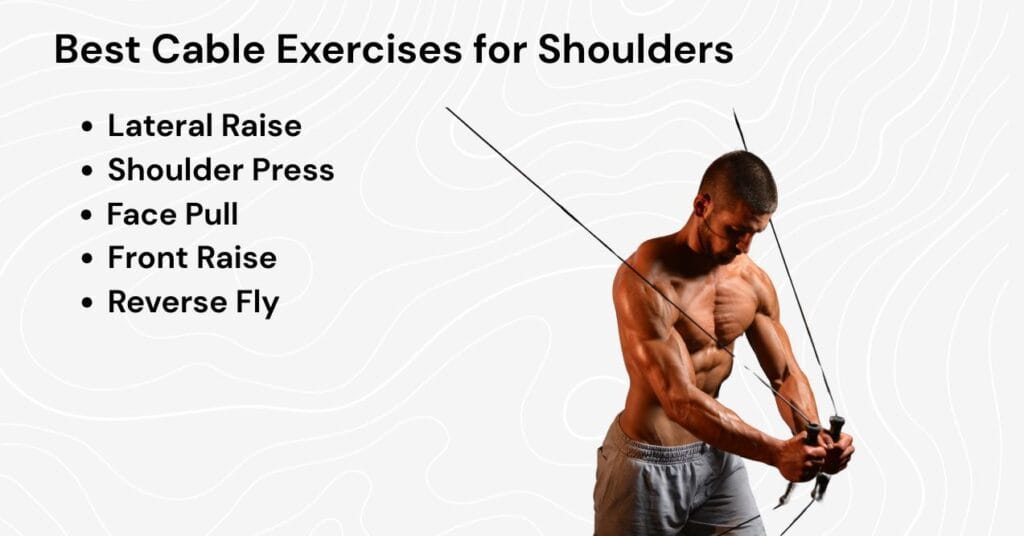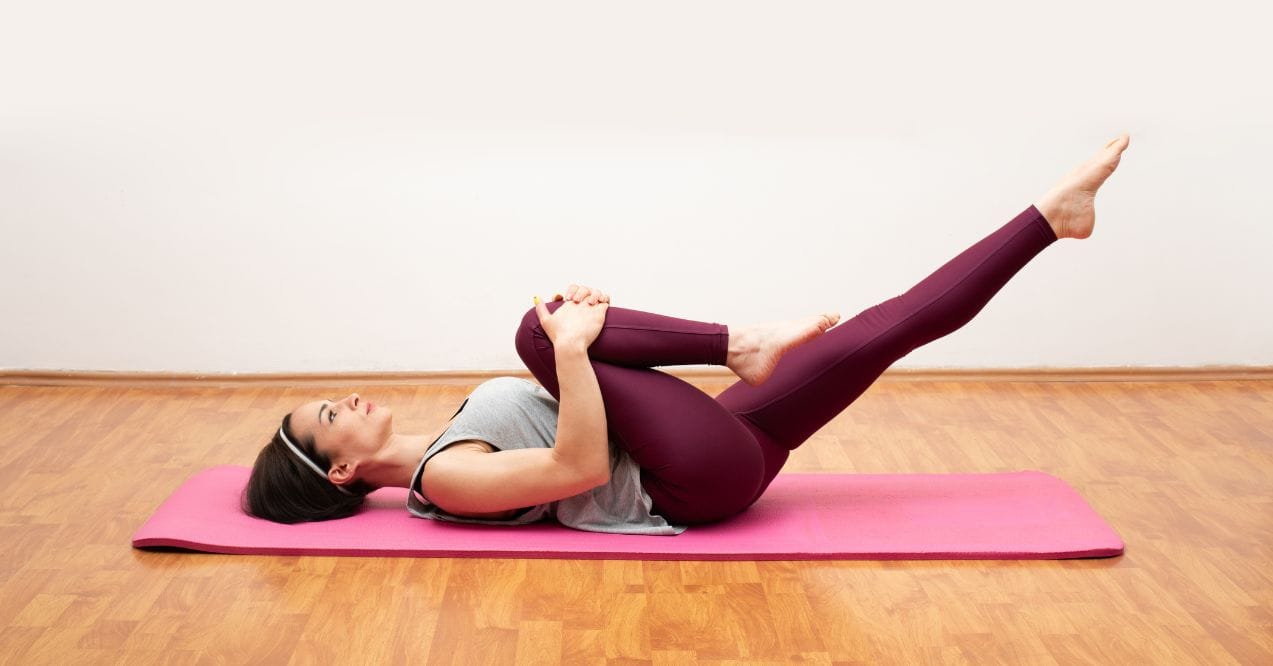Cable Exercises For Shoulders – Maximize Muscle Growth & Stability
Looking to build impressive, powerful shoulders? Cable exercises for shoulders offer a game-changing approach to developing strength and definition in this crucial muscle group. Unlike free weights, cables maintain constant tension throughout each movement, challenging your muscles from multiple angles and promoting superior muscle activation. This continuous resistance helps target all three heads of the deltoid – anterior, lateral, and posterior – creating balanced development and reducing injury risk.
Whether you’re a seasoned athlete or just starting with a 5 day hybrid training program for beginners, incorporating cable variations into your shoulder routine can dramatically improve your results. The versatility of cable stations allows for customized resistance levels and angles, making them perfect for beginners and advanced lifters alike. Ready to transform your shoulder training?

Understanding the Shoulder Muscles
The shoulder is one of the most complex and mobile joints in the human body, capable of movement in multiple directions. This impressive range of motion is made possible by several muscle groups working together, with the deltoid muscles being the primary movers for most shoulder actions.
The deltoid muscle has three distinct parts or “heads,” each responsible for different shoulder movements:
- Anterior (Front) Deltoid – Located at the front of your shoulder, this section is responsible for shoulder flexion and internal rotation. It’s heavily engaged when you raise your arms forward or perform pressing movements.
- Lateral (Middle) Deltoid – Positioned at the side of your shoulder, the lateral head is crucial for shoulder abduction – moving your arm away from your body to the side. This muscle gives shoulders their width and that sought-after “capped” appearance.
- Posterior (Rear) Deltoid – Found at the back of your shoulder, this often-neglected section controls shoulder extension and external rotation. It plays a vital role in posture and balanced shoulder development.
What makes cable machines particularly effective for shoulder training is their ability to maintain constant tension throughout the entire range of motion. Unlike free weights, which rely on gravity pulling in one direction, cables create resistance from the angle of the pulley, allowing for more diverse loading patterns.
This constant tension is especially beneficial for the deltoids because it forces them to work harder at points in the movement where free weights would normally provide less resistance. For example, at the top of a lateral raise, a dumbbell becomes easier to hold as it aligns with gravity, but a cable maintains tension, challenging the lateral deltoid at its fully contracted position.
Best Cable Exercises for Shoulders

When it comes to developing well-rounded, powerful shoulders, cable exercises for shoulders stand out as some of the most effective options available. The constant tension provided by cable machines creates an environment where your deltoids must work continuously throughout each repetition, maximizing muscle fiber recruitment and growth potential.
The following five exercises form the cornerstone of an effective cable shoulder routine, each targeting specific areas of the deltoid complex while contributing to overall shoulder development. By incorporating these movements into your training program, you’ll create balanced strength and aesthetics while promoting long-term shoulder health and stability.
Cable Lateral Raise
The cable lateral raise is perhaps the most effective isolation exercise for developing the lateral (middle) deltoid, which gives shoulders their sought-after width and capped appearance.
How to perform:
- Stand sideways to a cable machine with the pulley set at the lowest position.
- Grasp the handle with your outside hand.
- Keeping a slight bend in your elbow and your palm facing down, raise your arm out to the side until it’s parallel to the floor.
- Pause briefly at the top of the movement, focusing on squeezing the lateral deltoid.
- Slowly lower back to the starting position with control.
What makes this version superior to dumbbell lateral raises is the constant tension throughout the movement, particularly at the top position where the lateral deltoid is fully contracted. For variety, try single-arm versions, alternating arms, or even the cable crossover station to perform bilateral raises simultaneously.
Cable Shoulder Press
The cable shoulder press delivers impressive overall shoulder development while providing unique benefits that traditional barbell or dumbbell presses cannot match.
How to perform:
- Position yourself in the center of a cable crossover station, with pulleys set at the lowest position.
- Grasp a handle in each hand and stand with feet shoulder-width apart.
- Begin with your hands at shoulder height, palms facing forward.
- Press upward until your arms are fully extended overhead.
- Slowly return to the starting position, maintaining control throughout.
Unlike free weight presses, the cable version maintains tension on the deltoids even at the top of the movement, where barbells and dumbbells typically allow for momentary rest. This continuous engagement stimulates greater muscle fiber recruitment and can lead to enhanced strength gains.
Cable Face Pull
The cable face pull is one of the most valuable yet underutilized shoulder exercises, particularly for developing the posterior deltoids and promoting shoulder health.
How to perform:
- Set a cable pulley to upper chest height and attach a rope handle.
- Grasp the rope with both hands, palms facing each other.
- Step back to create tension on the cable and stand with feet shoulder-width apart.
- Pull the rope toward your face, focusing on driving your elbows back and out.
- At the peak of the movement, your hands should be near your ears with elbows flared.
- Return to the starting position with control.
This exercise not only builds the rear deltoids but also strengthens the rotator cuff muscles and mid-back, helping to correct the forward shoulder posture many people develop from daily activities. Regular performance of face pulls can dramatically improve shoulder stability and reduce injury risk, making them as therapeutic as they are muscle-building.
Cable Front Raise
The cable front raise directly targets the anterior (front) deltoid, creating definition and strength in the front portion of your shoulders.
How to perform:
- Stand facing away from a cable machine with the pulley set low.
- Grasp the handle with an overhand grip.
- Starting with your arm down and slightly in front of your body, raise the cable directly forward.
- Lift until your arm is parallel to the floor or slightly higher.
- Pause briefly at the top, then lower with control to the starting position.
The key advantage of the cable version is the consistent resistance throughout the movement, unlike dumbbells which create variable resistance based on lever arm length. For maximum effectiveness, avoid swinging or using momentum – this exercise should be performed slowly and with strict form. You can perform these one arm at a time or using both arms simultaneously for different training stimuli.
Cable Reverse Fly
The cable reverse fly is a premier exercise for developing the posterior deltoids and enhancing overall shoulder stability and posture.
How to perform:
- Set the cables at approximately chest height.
- Stand between the cable towers, grasping the left handle with your right hand and the right handle with your left hand (crossing cables).
- Step back to create tension and position your feet shoulder-width apart.
- With a slight bend in your elbows, open your arms out to the sides.
- Focus on squeezing your shoulder blades together at the peak of the movement.
- Return to the starting position with control.
This exercise effectively isolates the rear deltoids while also engaging the rhomboids and middle trapezius. The crossing cable setup creates a unique tension pattern that keeps the muscles engaged throughout the entire range of motion. Regular performance of reverse flys can help correct muscular imbalances that often develop from overemphasis on pressing movements, promoting healthier shoulders and improved posture.
Tips for Effective Cable Shoulder Workouts

To maximize your results with cable shoulder exercises, proper technique and training approach are essential. Here are key strategies to help you get the most from your cable shoulder workouts:
- Master the Mind-Muscle Connection – Focus intently on feeling the targeted deltoid muscle working throughout each exercise. This conscious connection improves muscle fiber recruitment and can significantly enhance results regardless of whether you’re training for lean muscle vs bulk.
- Control the Eccentric Phase – The lowering portion of each exercise is where significant muscle development occurs. Rather than letting the weight stack drop quickly, control the descent for a count of 2-3 seconds to increase time under tension and stimulate greater growth.
- Adjust Pulley Heights for Targeted Development – Experiment with different pulley heights for exercises like lateral raises and front raises. Slight adjustments can shift emphasis to different parts of the deltoid muscle, providing more comprehensive development.
- Incorporate Drop Sets – Cable machines are perfect for drop sets, where you perform an exercise to near failure, quickly reduce the weight, and continue without rest.
- Prioritize Range of Motion Over Weight – Using a full range of motion activates more muscle fibers than lifting heavier weights with partial movements. Select a weight that allows complete control throughout the entire range.
- Alternate Between Unilateral and Bilateral Training – Single-arm (unilateral) exercises address strength imbalances between sides, while two-arm (bilateral) movements allow for heavier loads. Include both types for optimal development.
- Stabilize Your Core – Engage your core muscles during all cable shoulder exercises to prevent compensatory movements and ensure the deltoids do the intended work.
- Periodize Your Training – Vary your approach between higher rep phases (12-15 reps) for promoting leaner muscle development and lower rep phases (6-8 reps) for building denser, stronger shoulders.
- Rest Appropriately Between Sets – For hypertrophy (muscle growth), rest periods of 60-90 seconds are typically ideal, while strength-focused training may require 2-3 minutes between sets.
Supporting your shoulder training with proper nutrition can dramatically enhance your results. Bone Broth Protein powder offers an excellent complement to your cable shoulder routine, delivering 20 grams of clean, high-quality protein per serving with a delicious chocolate flavor that makes post-workout nutrition something to look forward to. The collagen, glycine, and essential amino acids in this 98% pure formula work synergistically with your training to support lean muscle development and promote joint comfort – particularly important for shoulder health.
For even better performance benefits, consider pairing it with Trumeta Creatine, which delivers 5 grams of pure Creapure® creatine per serving. This powerful combination helps maintain cellular energy during high-intensity shoulder training while supporting the lean muscle development that cable exercises stimulate so effectively.
Both supplements integrate perfectly with cable shoulder workouts to help you achieve more defined, functional deltoids.
How to Target the Lateral Deltoid with Cables
The lateral (middle) deltoid is the muscle primarily responsible for giving shoulders that coveted wide, capped appearance. While many lifters struggle to develop this area, cable exercises offer unique advantages for lateral deltoid training that can lead to breakthrough results.
The standard cable lateral raise forms the foundation of lateral deltoid development. For maximum effectiveness, position yourself so the cable crosses in front of your body before beginning the raise. This creates tension at the bottom of the movement where dumbbells typically provide minimal resistance. Focus on leading with your elbow rather than your hand to ensure the lateral deltoid does the work.
For advanced stimulation, try these specialized cable variations:
- Leaning Cable Lateral Raise – Stand about two feet from the low pulley and lean away slightly. This position pre-stretches the lateral deltoid and is one of the most reliable signs of gaining muscle and losing fat when performed consistently.
- Dual Cable Lateral Raise – Using two low pulleys simultaneously creates balanced tension from both sides, preventing the common issue of rotating at the torso.
- High-to-Low Cable Lateral Raise – Set the pulley above shoulder height and pull downward and outward. This reverse angle challenges the lateral deltoid through a different resistance curve.
- Cable Y-Raise – Position between the angle of a lateral and front raise (about 30-45 degrees) to target the anterior/lateral tie-in area.
- Cable 21s – Perform 7 partial reps in the lower half of the range, 7 in the upper half, and 7 complete reps for intense metabolic stress.
For optimal development, perform lateral deltoid training when your shoulders are fresh, typically early in your workout, using moderate weights with perfect form for 10-15 controlled repetitions.
Common Mistakes to Avoid in Cable Shoulder Exercises
Even the most effective exercises can yield poor results when performed incorrectly. Avoid these common pitfalls to maximize your shoulder development with cable training:
- Using Momentum Instead of Muscle – Perhaps the most widespread mistake is swinging the body to move the weight rather than using the targeted deltoid muscles. This not only reduces effectiveness but increases injury risk. Solution: Choose a weight that allows strict form and controlled movement throughout the entire range of motion.
- Improper Cable Height Positioning – Setting the pulley at the wrong height changes the exercise mechanics completely. For example, a lateral raise with the cable set too high becomes more of a downward pull. Solution: Adjust the pulley to create resistance directly opposing the intended movement direction.
- Neglecting Full Range of Motion – Many lifters cut their cable shoulder exercises short, missing vital portions of the movement. Solution: Allow your shoulders to move through their complete range while maintaining proper form.
- Hunching the Shoulders – Shrugging or elevating the shoulders during cable work shifts emphasis to the upper trapezius instead of the deltoids. Solution: Keep your shoulders down and back throughout movements.
- Inconsistent Tempo – Rushing through repetitions or using uneven lifting speeds reduces tension on the muscles. Solution: Use a controlled tempo, especially during the lowering phase (about 2-3 seconds down).
- Wrist Position Errors – Allowing wrists to bend excessively during exercises can cause strain and reduce deltoid activation. Solution: Maintain neutral wrists through the full range of motion.
- Training Symmetrically Despite Imbalances – Many people have one stronger side but train both equally. Solution: Include single-arm cable exercises and prioritize your weaker side to create balanced development.
Conclusion
Incorporating cable exercises for shoulders into your training routine represents one of the smartest moves you can make for developing powerful, well-balanced deltoids. The constant tension provided by cable machines creates an ideal environment for muscle growth and stability development that free weights alone cannot match. By understanding the unique anatomy of your shoulder complex and implementing the five key exercises we’ve explored – cable lateral raises, shoulder presses, face pulls, front raises, and reverse flys – you’ll target each section of the deltoid for comprehensive development.
Remember to focus on proper form over heavy weights, maintain tension throughout each movement, and be patient with your progress. Whether you’re looking to build impressive shoulder caps, improve functional strength, or enhance posture, cable training delivers exceptional results when performed correctly. Your journey to stronger, more defined shoulders begins with these versatile, effective movements.
For optimal results, train shoulders with cables 1-2 times weekly, allowing 48-72 hours between sessions for recovery. More advanced lifters might incorporate lighter cable work up to 3 times weekly, focusing on different deltoid heads each session.
Prevent injuries by starting with lighter weights to master proper form, maintaining neutral spine alignment, avoiding shoulder shrugging, warming up thoroughly before training, progressing weight gradually, and keeping shoulders down and back throughout all movements.
Target side delts with cable lateral raises by standing sideways to the machine, pulling upward with a slight elbow bend, pausing at shoulder height, and controlling the descent. Lean slightly away from the cable for increased tension throughout the movement.
Advertisement. This site offers health, wellness, fitness and nutritional information and is designed for educational purposes only. You should not rely on this information as a substitute for, nor does it replace, professional medical advice, diagnosis, or treatment. If you have any concerns or questions about your health, you should always consult with a physician or other health-care professional. Do not disregard, avoid or delay obtaining medical or health related advice from your health-care professional because of something you may have read on this site. The use of any information provided on this site is solely at your own risk.







